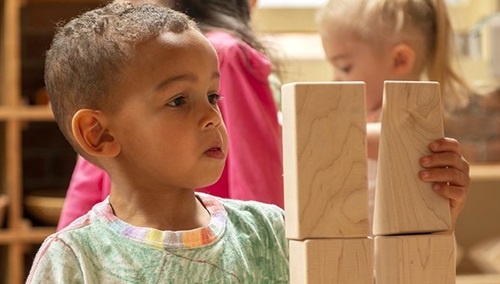Come Out and Play
| August 2012The boisterous, exuberant physical play of children is more than just fun; it's a vital part of their development. For the sake of children's health and their future, early childhood educators have a major role to play in protecting and promoting intense, vigorous play in childhood.
Young children have always played roughly with their bodies; all animal young do. Whatever you may call it – rough & tumble play, roughhousing, horseplay, or play fighting – this play style is vigorous, intense, and very physical. Physical play seems to occur most naturally while children are playing outside, on anything from a traditional playground to a grassy meadow. Children use natural playscapes by climbing onto and jumping off rocks or boulders, balancing on limbs, climbing into and jumping down from tree branches, and climbing up onto and then running back down grassy hillsides.
Although young children's big body play can be solitary, more often it includes other children. We see children running around, dancing and swirling, rolling on the floor or on the grass, or hopping and skipping along paths and trails. Children's rough play can also include objects. Children climb up onto structures like walls, and then leap off. Children may use large yoga balls and roll their bodies on them. They sometimes tag objects like fences as "base" and then race to them. We see them wrestle each other to the ground, swing each other around, chase and tag each other, and crawl on top of each other. Children play this way most often with other children they consider as friends.
Why It Matters
As in all appropriate play, when children involve their bodies in this vigorous, interactive, very physical kind of play, they are developing a range of skills representing every developmental domain. Most importantly, through their big body play children are learning physical skills – how their bodies move and how to control their physical movements. And because the play is so vigorous and enjoyable, children sustain their level of moderate-to-vigorous exercise required for optimum physical health. The National Association for Sport and Physical Education (NASPE) advocates for at least one hour of unstructured moderate – to – vigorous physical activity daily from toddler age through adulthood. This level of activity not only promotes optimum physical health, it can be a deterrent to childhood obesity.
Supporting Rough Play
Children's rough play occurs most naturally while they are outside. A wise teacher will take advantage of this, encouraging and supporting vigorous outdoor play. Children play more intensely and appropriately when the supervising adults are active too. When teachers model high levels of vigorous activity, children will play this way as well. Until about age 4, girls and boys are equally physically active. By preschool age, though, girls tend to stay in closer proximity to their predominantly female teachers and move around less. Preschool and school-age girls need their teachers – especially their predominantly female teachers – to model big, physical play. When teachers move around, run, climb, throw and catch, and fall down on the ground, children especially the girls – play this way, too. We want both girls and boys to be physically active, and to remain physically active long after their preschool years.
Rules for Big Body Play
In spite of its' multiple benefits, big body play is most productive and manageable when governed by guidelines and rules. Involve the children in the rules' creation. For example, you might decide that the slide will be used for sliding one day and climbing the next, or that a child can only climb up after checking to make sure no one is sliding down. You may want to agree that jumping can only be from stationary structures and never from swings. Make sure there is ample shock-absorbing ground cover wherever a child will jump. Rolling should be done down hills that are fenced or away from streets and/or traffic of any kind. Wrestling could have rules about only wrestling while kneeling, or arms around shoulders to waists but not around necks or heads. You may consider grassy areas okay for wrestling, but not the sand and concrete areas. Write the rules on white poster board, laminate them, and mount them near the designated rough play area.
Communicating with Families
It is important to make sure the families you serve understand why you support and encourage vigorous physical play. For example, you could:
- Include a policy on big body play in your handbook. Explain how it is supported and supervised on your playground.
- Send a letter to families that explains the importance and many benefits of very physical play.
- Use photographs of children engaged in vigorous activities to visually demonstrate big body play.
Going Forward
Children and their rough play: they all do it; we all did it. Research demonstrates convincingly that there is an enormous physical value in it. It's good for them, and it's good for us. Boisterous, exuberant body play comes naturally to children – all children. As educators we need to protect and promote it, and with it, their health.







